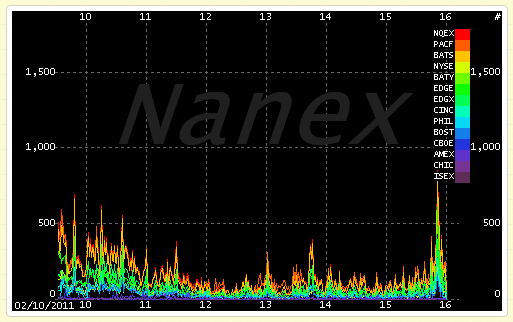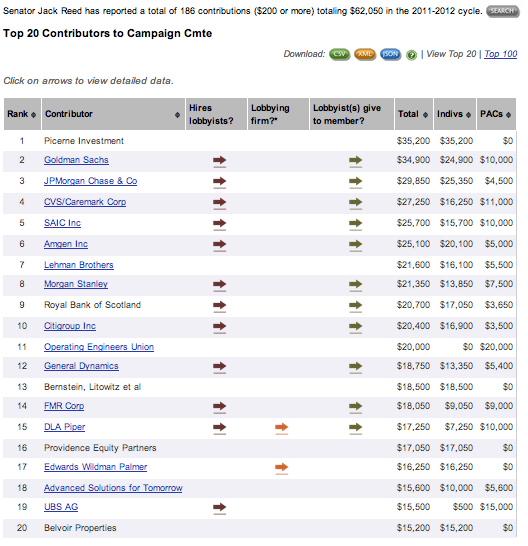A Senate panel is looking into the phenomenon of High Frequency Trading.
Here’s the infamous and hypnotic graphic from Nanex showing just how the practice has grown, showing volume by the hour every day since 2007 on various exchanges:
It is a relief that the issue is finally being discussed in wider venues, because we are witnessing a stunning exodus from markets as markets mutate into what we see above, a rampaging tempestuous casino of robotic arbitrageurs operating in millisecond timescales.
The conundrum is simple: how can any retail investor trust markets where billions of dollars of securities are bought and sold faster than they can click my mouse and open my browser, or pick up the phone to call their broker?
And the first day of hearings brought some thoughtful testimony.
The Washington Post notes:
David Lauer, who left his job at a high-frequency trading firm in Chicago last year, told a Senate panel that the ultra-fast trades that now dominate the stock market have contributed to frequent market disruptions and alienated retail investors.
“U.S. equity markets are in dire straits,” Lauer said in his written testimony.
Here are some common-sense rules for such a “new market”:
1. Every offer and bid will be left up for 15 minutes and cannot be withdrawn until 15 minutes has passed.
2. Every security–stock or option–must be held for a minimum of one hour.
3. Every trade must be placed by a human being.
4. No equivalent of the ES/E-Mini contract–the futures contract for the S&P 500 — will be allowed. The E-Mini contract is the favorite tool of the Federal Reserve’s proxies, the Plunge Protection Team and other offically sanctioned manipulators, as a relatively modest sum of money can buy a boatload of contracts that ramp up the market.
5. All bids, offers and trades will be transparently displayed in a form and media freely available to all traders with a standard PC and Internet connection.
6. Any violation of #3 will cause the trader and the firm he/she works for to be banned from trading on the exchange for life–one strike, you’re out.
However, I doubt that any of Smith’s suggestions will even be considered by Congress (let alone by the marketplace which seems likely to continue to gamble rampantly so long as they have a bailout line). Why? Money. Jack Reed, the Democratic Senator chairing the hearings, is funded almost solely by big banks and investment firms: 
It seems more than probable that once again Congress will come down on the side of big finance, and leave retail investors out in the cold. Jack Reed opened a recent exchange on Bloomberg with these words:
Well I believe high frequency trading has provided benefits to the marketplace, to retail investors, etcetera.
Yet retail investors do not seem to agree about these supposed benefits.
Retail investors just keep pulling funds: 
Reed failed to really answer this question posed by the host:
Senator, US equity markets are supposed to be a level playing field for all kinds of investors; big companies, small companies and even individuals. That said, how is it possible for an individual investor ever to compete with high frequency traders who buy and sell in milliseconds. Aren’t individuals always going to be second in line essentially to robots who can enter these orders faster than any human possibly can?
The reality is that unless regulators and markets can create an environment where individual investors can participate on a level playing field, they will look for alternative venues to put their money. It is in the market’s interest to create an environment where investors can invest on a level playing field. But I think the big banks are largely blinded by the quick and leverage-driven levitation provided by high frequency trading.
- English (UK)
- English (India)
- English (Canada)
- English (Australia)
- English (South Africa)
- English (Philippines)
- English (Nigeria)
- Deutsch
- Español (España)
- Español (México)
- Français
- Italiano
- Nederlands
- Português (Portugal)
- Polski
- Português (Brasil)
- Русский
- Türkçe
- العربية
- Ελληνικά
- Svenska
- Suomi
- עברית
- 日本語
- 한국어
- 简体中文
- 繁體中文
- Bahasa Indonesia
- Bahasa Melayu
- ไทย
- Tiếng Việt
- हिंदी
The High Frequency Trading Debate
Published 09/21/2012, 05:11 AM
Updated 07/09/2023, 06:31 AM
The High Frequency Trading Debate
Latest comments
Loading next article…
Install Our App
Risk Disclosure: Trading in financial instruments and/or cryptocurrencies involves high risks including the risk of losing some, or all, of your investment amount, and may not be suitable for all investors. Prices of cryptocurrencies are extremely volatile and may be affected by external factors such as financial, regulatory or political events. Trading on margin increases the financial risks.
Before deciding to trade in financial instrument or cryptocurrencies you should be fully informed of the risks and costs associated with trading the financial markets, carefully consider your investment objectives, level of experience, and risk appetite, and seek professional advice where needed.
Fusion Media would like to remind you that the data contained in this website is not necessarily real-time nor accurate. The data and prices on the website are not necessarily provided by any market or exchange, but may be provided by market makers, and so prices may not be accurate and may differ from the actual price at any given market, meaning prices are indicative and not appropriate for trading purposes. Fusion Media and any provider of the data contained in this website will not accept liability for any loss or damage as a result of your trading, or your reliance on the information contained within this website.
It is prohibited to use, store, reproduce, display, modify, transmit or distribute the data contained in this website without the explicit prior written permission of Fusion Media and/or the data provider. All intellectual property rights are reserved by the providers and/or the exchange providing the data contained in this website.
Fusion Media may be compensated by the advertisers that appear on the website, based on your interaction with the advertisements or advertisers.
Before deciding to trade in financial instrument or cryptocurrencies you should be fully informed of the risks and costs associated with trading the financial markets, carefully consider your investment objectives, level of experience, and risk appetite, and seek professional advice where needed.
Fusion Media would like to remind you that the data contained in this website is not necessarily real-time nor accurate. The data and prices on the website are not necessarily provided by any market or exchange, but may be provided by market makers, and so prices may not be accurate and may differ from the actual price at any given market, meaning prices are indicative and not appropriate for trading purposes. Fusion Media and any provider of the data contained in this website will not accept liability for any loss or damage as a result of your trading, or your reliance on the information contained within this website.
It is prohibited to use, store, reproduce, display, modify, transmit or distribute the data contained in this website without the explicit prior written permission of Fusion Media and/or the data provider. All intellectual property rights are reserved by the providers and/or the exchange providing the data contained in this website.
Fusion Media may be compensated by the advertisers that appear on the website, based on your interaction with the advertisements or advertisers.
© 2007-2024 - Fusion Media Limited. All Rights Reserved.
